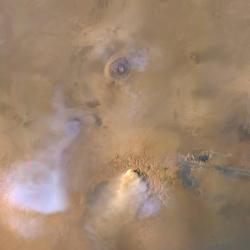Solar flares threaten space travel
Solar flares frequently occur during periods of high solar activity: sudden increases in brightness of a small region of the chromosphere or corona, almost always in the vicinity of a sunspot. Radiation (X, radio and optical) is emitted and warn for danger.
Some particles are accelerated to very high energies (several gigaelectronvolts) during Solar Energetic Particles (SEP) events and pose a major threat to interplanetary space travel.
Solar flares in 3 stages
Solar flares follow three stages that can last from a few seconds to a few hours depending on the event.
- The precursor stage releases energy in the form of X-rays.
- The main stadium is associated with the emission of a flash in visible light, but also with the emission of electromagnetic radiation in the entire spectrum from gamma radiation to radio waves.
- The final stage is the decline during which only soft x-rays are detected.
The protuberances are composed of dense and cold plasma (still 10,000 K, but less hot than the corona) bathing in the hot plasma of the corona and confined by the coronal magnetic field.
They sometimes form arches that can rise to a million km above the chromosphere and persist for several days.
Plasma bubbles that release enormous amounts of material
Coronal Mass Ejections (CME) are gigantic plasma bubbles produced in the solar corona that release enormous amounts of material that disrupt the normal flux of the solar wind and pose a threat to space missions.
The phenomenon was observed for the first time in 1973 by the telescope of the US SKYLAB station.
A coronal mass ejection travels at speeds of up to 1000 km/s and is denser than the normal solar wind.
Even though particle velocities are very high, they take several tens of hours to a few days to reach the Earth, much more time than light that takes only 8 minutes to cross the 150 million km that separate the Earth from the Sun. Terrestrial disturbances due to these solar events can therefore be partially anticipated in advance.
Carrington’s exceptional event
The largest solar flare was observed on September 1, 1859 by the British astronomer Richard Carrington. Spots, so large that they were visible to the naked eye, had appeared on the surface of the Sun for a few days. They were associated with a flash of light that lasted about five minutes, the starting point for an exceptional solar flare.
A magnetic storm disturbed the Earth 17 hours later, producing visible auroras even in tropical regions and strong disturbances in telegraph communications. Testimonies affirmed that it was possible to read a newspaper in the middle of the night thanks to the auroral light up to latitudes as low as Panama.
This is how a link could be established between solar flares and terrestrial disturbances, leading to space weather. Such an extreme solar storm, if it were to occur now, could cause global disruptions to satellites, telecommunications and power distribution.
Numerous eruptions have occurred since 1859, but never on such a scale.




